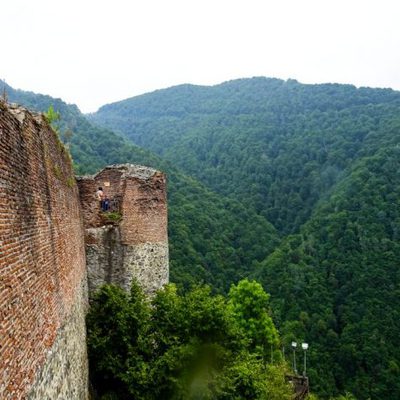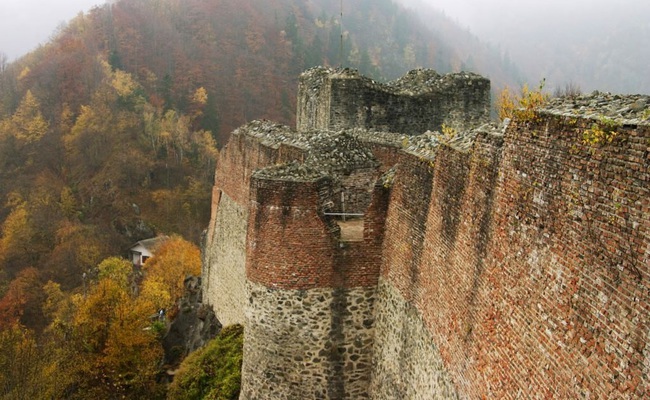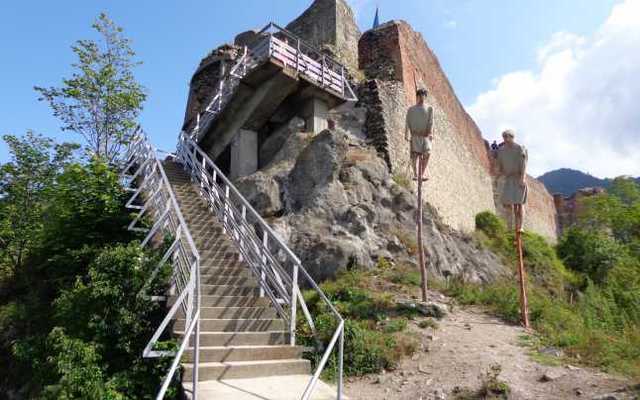The Poenari Fortress
Geographic position
The Poenari Fortress is located on a mountain peak that dominates the Argeș Gorges, near Arefu village, 4 kilometers from the Vidraru dam and lake, on the lower valley, near the Vidraru hydroelectric power station. The Poenari Fortress is on a mountain peak, about 400 meters from the level of the valley. The fortress has an elongated shape and has 5 towers, 4 round ones and a prismatic one.
The walls are 2-3 meters thick. At an altitude of 850 meters, the Poenari Fortress, also known as the "eagle's nest of the old calves", was erected, a fortress that belonged, centuries ago, from a chain of fortifications that defended the northern border of the Romanian Country. Poenari Fortress is at a distance of 27 km from Curtea de Arges, on a small plateau at the top of the Cetatuia Mountain, which is reached by climbing 1,480 concrete steps, meandering through a dense beech forest.
In the Keys of Arges, on a rocky mountain are seen the ruins of the fortress, which is said to have been built by Vlad Tepes. In fact, he is the one who rebuilt the fortress known as Poenari Fortress (after the old name of Poenari village), probably being built in the 14th century as a place of refuge by the legendary Lord Negru Voda, to which are also attributed the two signs near the cliff top. Initially, during Negru Voda's time, a single tower was built; then the construction was developed for the purpose of shelter or observation point by Vlad Țepeș, adding towers, walls and outbuildings. Poenari Fortress was the secondary residence of Vlad Țepeș, being built as a fortress against the Ottomans. The fortress is mentioned in a document issued by the Hungarian king Ladislau the fifth Postumul. 
Own legends and associations:
Archaeological research shows that Poenari Fortress was built before the reign of Vlad Tepes, at the end of the 13th century or the beginning of the 14th century. The construction of the fortress was part of a strategic plan for the surveillance and defense of the northern mountain border, along with other cities: Citizens, Lotru, Stoenesti, etc. The fortress's enclosure was protected by a prismatic tower built of rough stone and another three or four almost circular towers that had the upper part built of brick.
The defense walls are 2 to 3 meters thick. The entrance to the fortress was made below the stone tower, on a movable bridge. Once this bridge was erected, the fortress became completely isolated. Those from the fortress could exit through a secret gallery in a place on the Arges Valley called "at the cellars". Due to the legend of Dracula, known throughout the world, in the 1960s the Poenari Fortress was restored, and the tourists' access facilitated by the construction of some bridges and steps. Legend has it that Vlad Țepeș, being pursued by the Turks, escaped to take refuge in this fortress, after stumbling on horses with reverse horses, face to face, thus confusing his followers.
This place reminds some of the battle named by Nicolae Iorga "Battle of the Posada", from October 9-12, 1330, which marked the emancipation of the Romanian Country under the guardianship of the Hungarian crown. The battle is mentioned in the Chronicle painted in Vienna, without an exact identification of the place where it happened.
The position of that "inn", a common noun meaning transient, [1] is not known. King Carol Robert of Anjou of Hungary came on an expedition to punish his former vassal Basarab I of the Romanian Country (the country of Ungrovlahiei, as it was called, that is, the country of the Vlachs from Hungary), who from 1327 had refused to pay the tribute. vassal. King Carol Robert was defeated while retreating, in a place described by Sigismund of Luxembourg in a 1395 document as "on [...] the tops of the mountains," said in the usual [local] talk the inn, through some narrow and narrow paths, squeezed between large bushes ”.
In the 13th century, there was only a tower of rough stone, but, in the fourteenth century, the fortification covered the entire cliff with thick walls of broken stone, lined in the upper parts with brick.
The construction could accommodate only a garrison of about 30-40 soldiers and had an elongated shape, thick walls of two meters and five defense towers: four round and one prismatic one. Although in the "Letopisetul Cantacuzinesc" it is said that the fortress was lifted from the command of Vlad Tepes who, wanting to punish the boyars and the Targovets: "When it was Easter day, all the townspeople were at the party, and the young people in the hour, so without news surrounded them, and the elderly drew in fear of going around the city with them, and the young people with their wives, so adorned as they were, everyone took them to Poenari, to work. at the fortress until the clothes on the dances are broken ", it seems that this event is only related to its restoration.
The fortress was the last refuge of the ruler before leaving for Transylvania.
It was one of the fortifications that contributed to the final victory of the Romans in 1462.
Another legend says that Vlad Tepes, in 1462, being picked up and pursued by the hostages of Mehmet II, withdrew with a few hostages inside the fortress Poenari. The Turks besieged the fortress, bombed it from the neighboring mountain - Pietraria - and demolished its walls. The voivodship managed to flee to Arefu village. It is said that there he met seven blacksmith brothers, by the name of Dobrin, who at Voda's request changed the horses' horseshoes by putting them in reverse. The pursuers were deceived and took it in the wrong direction, Vlad Tepes managing to reach the front of his army again.
Another legend about Poienari fortress, known as the Lady River, talks about the king' s wife, who, finding out that Turkish are nearby, and feeling no escape, climbed the rocks on the Argeș river, yelling that she refused to be the Turkish pisoner.Then she dived into the edge, her body crushing of the river rocks.
The place where she died became red because of her blood, this being seen even nowadays. The last restauration of the fortress was made between 1969- 1972, when the walls were consolidated and access stairs were built which allow the visiting of the whole fortress in the best conditions